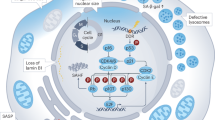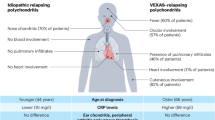Abstract
According to current studies, COVID-19 might have an impact on semen quality. Therefore, SARS-CoV-2 may affect other traits of male reproductive system, including the prostate. Thus, we recruited patients who experienced COVID-19 infection in-between prostate biopsy and radical prostatectomy and compared prostate samples inflammation, measured with IRANI score, to those who did not. Indeed, we recruited 20 patients, aged 69 (62–73) years, finding no difference between the 10 patients with COVID-19 infection and the others in IRANI score and all its sub-scores. Hence, according to our exploratory and limited results, COVID-19 infection might have no gross effect on prostate inflammation.
Similar content being viewed by others
COVID-19, a severe acute respiratory syndrome due to coronavirus 2 (SARS-CoV-2) infection was declared as a pandemic by the World Health Organization (WHO) in March 2020. Even if respiratory droplets and physical contact of contaminated surfaces are the established transmission modality of SARS-CoV-2, the virus has also been detected in saliva, teardrops, urine, and stool [1].
The evidence about the impact of Sars-Cov-2 on the urological organs remains sparse, so every step forward could allow a significant improvement of our knowledge in this challenging field.
From a pathological standpoint, a key role for the renin–angiotensin system in the infection process was reported, using the angiotensin-converting enzymes 2 (ACE2) receptors and the Transmembrane serine protease 2 (TMPRSS2) as “cell gates” [2]. Therefore, given the expression of ACE2 in the prostate gland and the increasing evidence regarding the worsening of lower urinary tract symptoms (LUTS) during COVID-19 infection, some studies investigated the relationship between COVID-related inflammation and benign prostatic hyperplasia [3], but no pathological evaluation about the impact on the local environment has been reported, yet.
To fill this gap, we assessed the potential role of COVID-19 on prostate inflammation, comparing the pathological samples from men diagnosed with COVID-19 and prostate cancer between the biopsy and the radical prostatectomy (RP) with a control group whose not.
After Ethical Committee approval (CE: 17104), our perspective maintained institutional database was reviewed to identify patients with Sars-Cov-2 infection between prostate biopsy and RP. The inclusion criteria were: (1) adult patients (age ≥ 18 years) with pathological diagnosis of prostate cancer occurred between March 2020 and September 2021; (2) patients treated with RP.
An a priori power analysis was not performed, considering the poor available data and the “pilot nature” of the current study.
While patients infected by COVID-19 between prostate biopsy and RP were enrolled in the case group, the others were included in the control one. In particular, the control group was created randomly selecting those patients with comparable characteristics in terms of comorbidities, tumor stage, and age without previous history of COVID-19 infection to reduce potential confounding.
Preoperative patients’ characteristics, comorbidities, and tumor stage were evaluated. All histopathological samples were reviewed by an expert pathologist (M.R.) and classified according to the IRANI score [4].
All patients were tested with SARS-CoV-2 swabs before prostate biopsies and surgical procedures according to our institutional protocol.
Descriptive statistics were obtained reporting median and interquartile ranges (IQR) for continuous variables, while numbers and proportions for categorical variables, as appropriate. Statistical analyses were performed using SPSS v. 26 (IBM SPSS Statistics for Mac, Armonk, NY, IBM Corp). All tests were two-sided with a significance set at p < 0.05.
Overall, 20 patients were enrolled in the study cohort. Of these, ten were infected by COVID-19 between prostate biopsy and RP (case group), and ten were enrolled in the control group.
No significant differences in terms of patients’ preoperative characteristics, tumor stage, PSA level, and prostate volume were reported between the case and control groups (Table 1).
The main reason to perform the prostate biopsy was suspicious lesion on prostate multiparametric magnetic resonance imaging.
The median time between biopsy and RP was 45 (40–60) days in the control group and 60 (55–70) in the case group (p = 0.01), due to COVID-19 infection. No significant differences have been observed in terms of overall inflammation grading scores and subscores between the groups, using the IRANI score.
Despite some studies [5, 6] have recently reported the presence of SARS-CoV-2 genome and inflammatory chemokines in the semen of sexually active men recovered from COVID-19, the main cause of semen impairment during COVID-19 infection is still under debate [5,6,7]. Indeed, male reproductive organs were found impaired in a high rate of patients recovered from moderate to severe COVID-19, with subsequent hypergonadotropic hypogonadism, erectile dysfunction, and orchitis [8]. In addition, while some studies evaluated the effect of viral infection on prostate features, and its potential relationship with LUTS and semen impairment [3, 5, 9], our work provides a relevant nuance in this field, focusing on the histopathological evaluation before and after the infection of prostate tissues. In this regard, while previous studies reported microthrombi in the prostate, after a fatal COVID-19 infection with a mild focal interstitial mononuclear inflammation [10], our preliminary findings suggest the absence of gross structural histopathological damage of the prostate during COVID-19 infection. Therefore, microthrombi might be the consequence of multiple organ failure in severe COVID-19 diseases, causing the reported mild mononuclear invasion.
In conclusion, despite several limitations, including the retrospective design, short follow-up, absence of randomization, small sample size, and high risk of selection bias, to the best of our knowledge this “pilot study” represents the first pathological investigation regarding inflammatory changes in prostate gland caused by COVID-19 infection.
Further larger studies are needed to confirm our preliminary findings and to investigate other potential pathological mechanisms that could explain the relationship between LUTS worsening and COVID-19 infection.
Data availability
The datasets generated during and/or analysed during the current study are available from the corresponding author on reasonable request.
References
Peng L, Liu J, Xu W, Luo Q, Chen D, Lei Z, et al. SARS-CoV-2 can be detected in urine, blood, anal swabs, and oropharyngeal swabs specimens. J Med Virol. 2020;92:1676–80. https://doi.org/10.1002/jmv.25936.
Hoffmann M, Kleine-Weber H, Schroeder S, Krüger N, Herrler T, Erichsen S, et al. SARS-CoV-2 cell entry depends on ACE2 and TMPRSS2 and is blocked by a clinically proven protease inhibitor. Cell. 2020;181:271–80. https://doi.org/10.1016/j.cell.2020.02.052.
Haghpanah A, Masjedi F, Salehipour M, Hosseinpour A, Roozbeh J, Dehghani A. Is COVID-19 a risk factor for progression of benign prostatic hyperplasia and exacerbation of its related symptoms?: a systematic review. Prostate Cancer Prostatic Dis. 2021. https://doi.org/10.1038/s41391-021-00388-3.
Irani J, Levillain P, Goujon JM, Bon D, Doré B, Aubert J. Inflammation in benign prostatic hyperplasia: correlation with prostate specific antigen value. J Urol. 1997;157:1301–3. https://doi.org/10.1016/s0022-5347(01)64957-7.
Gacci M, Coppi M, Baldi E, Sebastianelli A, Zaccaro C, Morselli S, et al. Semen impairment and occurrence of SARS-CoV-2 virus in semen after recovery from COVID-19. Hum Reprod. 2021;36:1520–9. https://doi.org/10.1093/humrep/deab026.
Morselli S, Sebastianelli A, Liaci A, Zaccaro C, Pecoraro A, Nicoletti R, et al. Male reproductive system inflammation after healing from coronavirus disease 2019. Andrology https://doi.org/10.1111/andr.13138.
Gul A, Zengin S, Dundar G, Ozturk M. Do SARS-CoV-2 infection (COVID-19) and the medications administered for its treatment impair testicular functions? Urol Int. 2021:1–5. https://doi.org/10.1159/000517925.
Nassau DE, Best JC, Kresch E, Gonzalez DC, Khodamoradi K, Ramasamy R. Impact of the SARS-CoV-2 virus on male reproductive health. BJU Int. 2021. https://doi.org/10.1111/bju.15573.
Nabeeh H, Ibrahim A, Taha D-E, Talaat M, Abdelbaky TM. Impact of COVID-19 pandemic on lower urinary tract symptoms in patients with benign prostatic hyperplasia and predictors of urine retention in such patients. Low Urin Tract Symptoms. 2021. https://doi.org/10.1111/luts.12407.
Al Nemer A. Histopathologic and autopsy findings in patients diagnosed with coronavirus disease 2019 (COVID-19): what we know so far based on correlation with clinical, morphologic and pathobiological aspects. Adv Anat Pathol. 2020;27:363–70. https://doi.org/10.1097/PAP.0000000000000276.
Acknowledgements
Authors thank Institutions, including both University of Florence and Careggi University Hospital and Regione Toscana for their support.
Author information
Authors and Affiliations
Contributions
Conception and Design: MG, SS. Acquisition of data: AM, RN, AL. Analysis and interpretation of data: AS, SM, AP. Drafting the manuscript: SM, AP. Critical revision of the manuscript: MG, SS, MRR, RC. Statistical anlysis: SM, AP. Administrative, technical, or material support: SM, MRR. Supervision: SS. Ethical approval: SM.
Corresponding author
Ethics declarations
Competing interests
The authors declare no competing interests.
Ethics approval and consent to participate
Approval of the research protocol by an Institutional Reviewer Board – Comitato Etico Area Vasta Toscana Centro ref: 17104.
Additional information
Publisher’s note Springer Nature remains neutral with regard to jurisdictional claims in published maps and institutional affiliations.
Rights and permissions
About this article
Cite this article
Pecoraro, A., Morselli, S., Raspollini, M.R. et al. The role of COVID-19 in prostate tissue inflammation: first pathological evidence. Prostate Cancer Prostatic Dis 25, 370–372 (2022). https://doi.org/10.1038/s41391-022-00542-5
Received:
Revised:
Accepted:
Published:
Issue Date:
DOI: https://doi.org/10.1038/s41391-022-00542-5
This article is cited by
-
Prevalence of lower urinary tract symptoms in taxi drivers: a cross-sectional web-based survey
Prostate Cancer and Prostatic Diseases (2023)
-
Mobile health: a promising tool for the management of male patients with lower urinary tract symptoms suggestive of benign prostatic hyperplasia
Prostate Cancer and Prostatic Diseases (2023)



